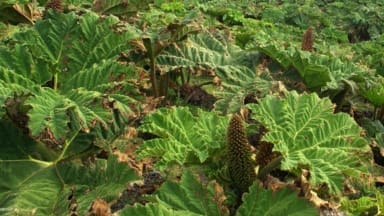
In his compelling article in the June 2024 issue of The Garden, botanist James Armitage provided insights into the parentage of the iconic Gunnera which led it to fall foul of invasive plant legislation. Gunneras have been grown in this country for over 150 years, and their plantings are often the most memorable feature in gardens across the UK. Just think Trebah, Tresselick and the Lost Gardens of Heligan in Cornwall.
Not just upsetting, but the ban on Gunnera is complex. Late 2023, the plant we have habitually grown as being Gunnera manicata (now known as G. x cryptica) was banned on account of it actually being a hybrid of G. manicata and G. tinctoria. From then on, it became illegal to plant, transport or cultivate it.
According to Armitage G. tinctoria was brought to Europe in the 1830’s from Chile and G. manicata arrived from Brazil thirty years later. G. tinctoria proved an avid self-seeder, rapidly threatening native plants and hence became banned in 2017. Importantly, G. manicata on the other hand, rarely – if ever, produced any seedlings in cultivation.
Startling DNA results revealed that what had been cultivated was not G. manicata but in fact a hybrid species of the two and it’s assumed the cross happened shortly after manicata was introduced. Unable to cope with the cold winter conditions, manicata is thought to have died out, and being made of stronger stuff, the hybrid survived.
The lack of seedlings seen to date, however does mean that the cross is in effect, sterile. However, regardless of its behaviour G. x cryptica was still banned by association.
“The banning of G. x cryptica is an example of legislation not flexible enough to accommodate the nuances of a complex situation. New scientific insight should allow for more robust, fairer rulings rather than decision-making by numbers” writes Armitage. Especially so, considering the impact of the ban for gardens. The RHS made the heartbreaking decision to destroy the plants in some of their gardens after it was added to the banned list.
Armitage makes the point that where the resilience of plants is such that they spread and dominate outside of the boundaries of cultivation such as Japanese knotweed, water primrose (ludwigia grandiflora) they are to be considered invasive and face control measures. Judging which pose a problem (in future) is however a difficult decision that requires substantial research. Some introductions, such as the horse chestnut (Aesculus hippocastrum), sweet chestnut (Castanea sativa), Acer pseudoplatanus and even the corncockle (agrostemma githago) have become ‘honorary natives’ despite spreading over their cultivation boundaries. Recent genetic analysis of the hybrid bluebell (Hyacinthoides x massartiana) which though demonised for being an aggressive threat to the native bluebell, indicates that it has actually had little impact on wild populations.
Similar research into G. x cryptica, may prove that it does not behave as invasively as its aggressive cousin G. tinctoria. “Perhaps it’s too much to hope that in the future, the verdict on this iconic plant might be reconsidered”, writes Armitage.
James Armitage is a botanist and editor of the RHS quarterly magazine, The Plant Review.

